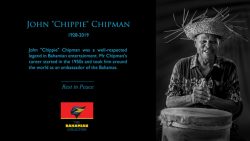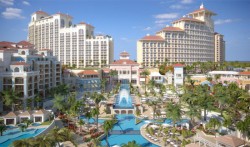The Commonwealth of the Bahamas is blessed with an abundance of marine-life and relatively healthy coral reefs, which together help to make this island nation one of the most popular dive-destinations in the world.
In January 2000, with the goals of preserving biodiversity, environmental quality and the economically important tourism and fishing industries, the then- government publicly identified five sites that would eventually host new marine reserves making the historic first steps in an ambitious and visionary plan to eventually protect some 20% of the Bahamian marine environment.
By doing this, they re-established the reputation of the Bahamas as a world-leader in marine conservation.
Although the nation had designated one of the largest and most successful marine reserves in the world (the Exuma Cays Land and Sea Park) in 1959, few marine reserves had been established since that time.
Unfortunately however, very little progress has been made on establishing the five new reserves since their inception. Instead, the new government has quietly stalled plans to develop this network of marine reserves and have given the go-ahead to foreign developers to build on some of the most biologically rich and sensitive coastal eco-systems in the western Atlantic, including at least one of these approved reserve sites.
An easy, 50 mile boat-ride east of South Florida, the islands of Bimini annually attract thousands of boaters, divers and recreational anglers anxious to enjoy the natural beauty of the Bahamas and escape the trials of city-life.
Comprised of two small islands (less than ten square miles in total area) surrounding a shallow seagrass dominated lagoon, Bimini possesses the only mangrove forests on the entire western edge of the Great Bahama Bank.
This exceptionally productive ecosystem supports a great diversity of commercially and culturally important aquatic species, such as the Caribbean spiny lobster, bonefish and queen conch, as well as a number of endangered species, including the hawksbill sea turtle, great hammerhead shark and smalltooth sawfish.
In one recent study, marine scientists identified over 110 species of fish and macro-invertebrates in the northern reaches of this lagoon (the North Sound), many of which utilize this rich habitat as a nursery ground, before later moving to the coral reefs.
Anyone who has had the privilege of diving around Bimini coral reefs will attest to the abundance and diversity of marine life that live around these islands, many of which undergo part of their life-cycle in the lagoon, among seagrasses and mangrove prop roots.
In fact, one can verify the diversity and abundance of fish-life around Bimini simply by thumbing through Paul Human’s popular “Reef Fish Identification” book and noting how frequently voucher underwater photographs of various fish species come from Bimini.
When the North Sound of Bimini lagoon was approved as a future marine reserve site, local reaction was generally positive, because the majority of local Bahamians derive much of their income from marine ecotourism or commercial fishing and recognized that a well-managed reserve would ultimately enhance these activities and benefit the community and local economy.
Despite the local support for a marine reserve, Bimini lagoon is now under threat from Miami-based developers who, with the permission of Bahamian government, have begun construction of a huge resort and casino on the narrow strip of land that is North Bimini.
The long-range plan of these developers is to dredge sediments from the lagoon and develop and dredge much of the North Sound, destroying extensive stands of mangroves and sea-grasses, in order to make enough land to expand the resort and create a golf-course.
Not only will this devastate productive breeding and foraging grounds for many reef animals, but the silt from dredging and subsequent fertilizer-laden run-off from the golf course will likely directly threaten the health of coral reefs themselves.
Long-range plans also include dynamiting through coral reefs on the western side of North Bimini in order to build a cruise-ship dock, a move that would destroy several important dive-sites including the world famous “Bimini Road”.
While a modest-sized resort that carefully integrated itself into this quaint seaside community and strived to market what the islands naturally have to offer (i.e. pristine coastal habitats, tranquility, diving, fishing), would probably enhance Bimini’s economy and provide quality employment for the locals, this massive development instead aims to fundamentally transform these islands and sacrifice world-famous diving and fishing for gambling and golf.
With its natural resources stripped away, tiny Bimini will then be forced to directly compete for tourists with a plethora of resorts in the region and with South Florida itself, historically an important source of visitors.
While thousands of South Floridians frequently throw their fishing poles or dive gear on their boats and then motor over to Bimini for a few days to get away from it all, most of them live within easy driving distance to world class golfing, gambling opportunities and beaches crowded with buildings, and will thus likely stop visiting Bimini if the islands diving, fishing and natural beauty are compromised.
Their island home, livelihoods and way of life gravely threatened, residents of Bimini and many other Bahamians vocally oppose the size of this construction, the destruction of mangroves and the loss of the North Sound for a golf course.
Although there are many obvious, environmentally-sound comprises that the developers and government could try to make that would likely be accepted by the locals (e.g. reducing the scope of the current development; abandoning the especially destructive construction of a golf course; integrating a reserve into the marketing plan for a revised, smaller resort), none have been made at present.
Unfortunately, problems of this nature are not localized to Bimini. Elsewhere in the Bahamas, relatively pristine coral reefs and mangrove wetlands like those of Bimini are under impending threat of development, while solid steps by the government to continue the creation of marine reserves have virtually ceased.
Given the accelerating pace of foreign development against a backdrop of stalled conservation planning in the Bahamas, it is imperative that the government acts now to reign in developers and resurrect plans to establish meaningful marine reserves in Bimini and the other four locations previously agreed upon, in order to begin to find a sustainable balance between economic development and the preservation of the relatively unspoiled island paradise that Bahamian citizens and thousands of foreign visitors currently enjoy.
By creating the Exuma Cays Land and Sea Park almost fifty years ago, the Bahamians ultimately helped show the world the effectiveness of a large, well-managed marine reserve in preserving fragile marine ecosystems.
Now, the current government ministers must learn from the example set by their own countrymen and strive to meet the goal of developing a national marine reserve network in the Bahamas.
By EVAN T. ALLARD – CDNN Eco News Editor
Published by CDNN – CYBER DIVER News Network
http://www.cdnn.info/



